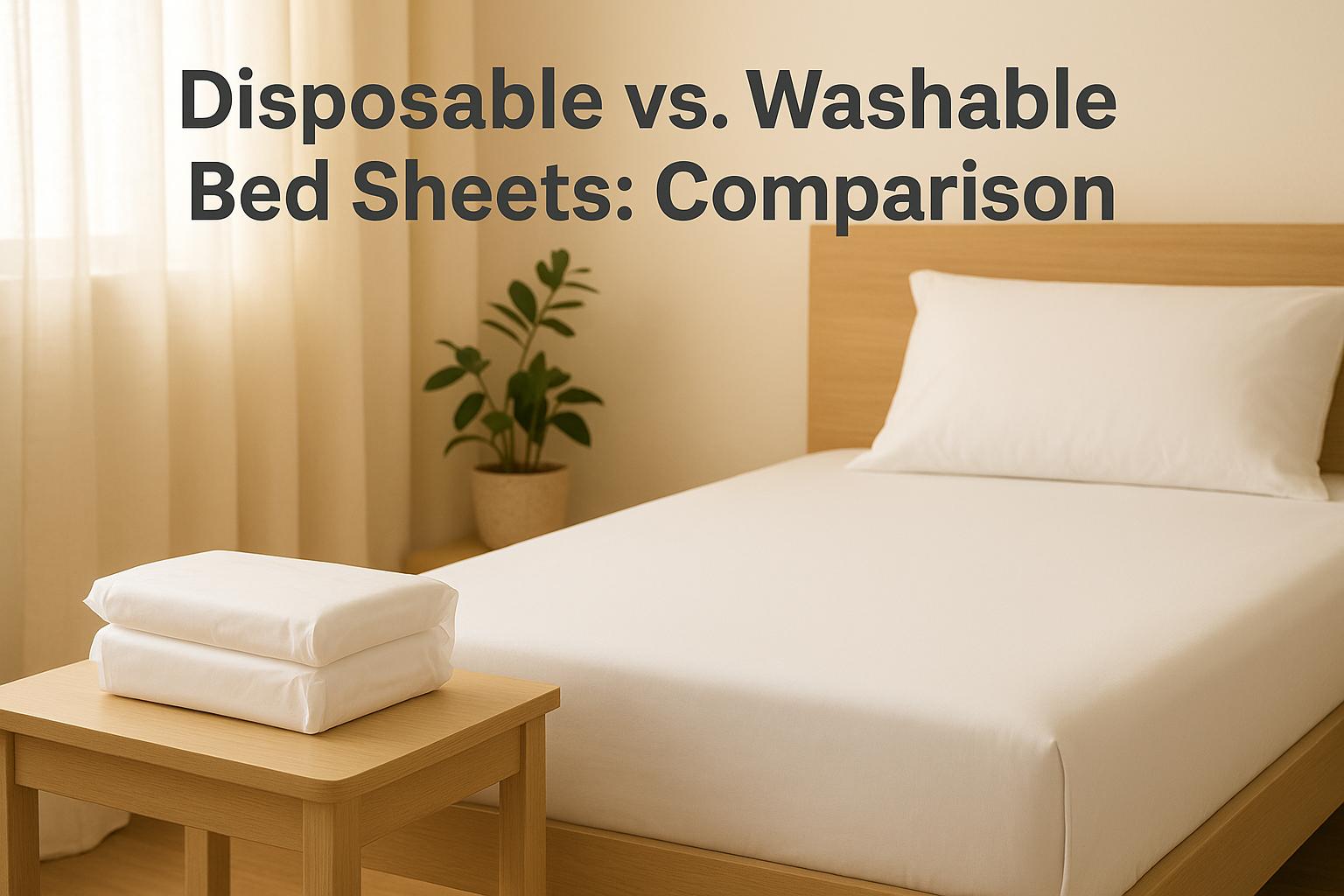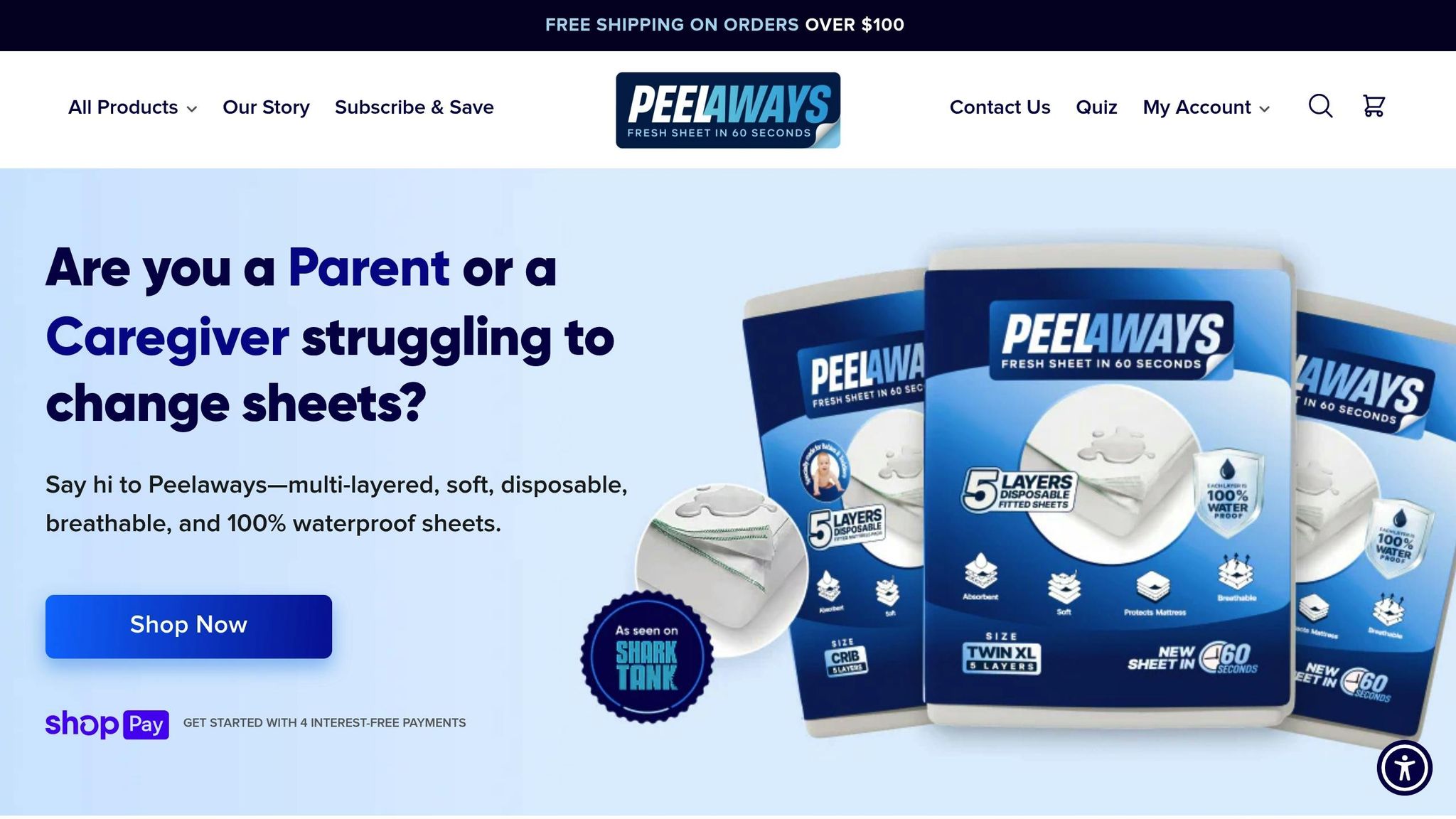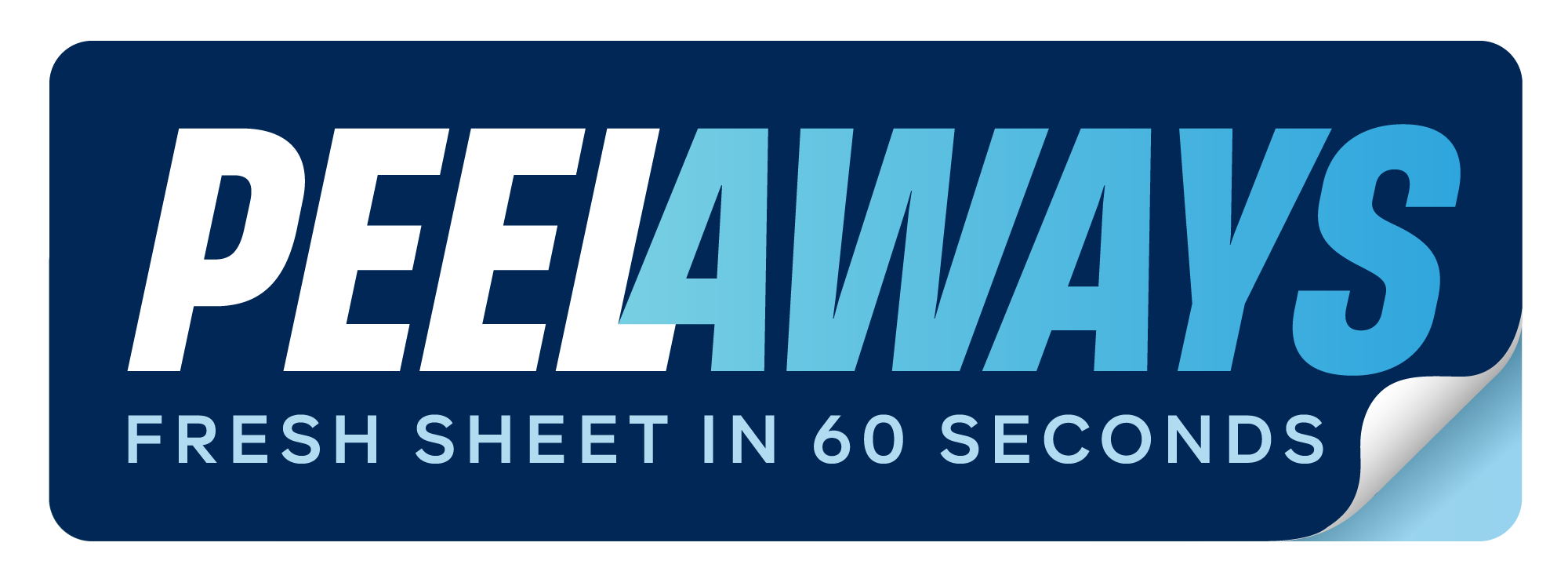Disposable vs. Washable Bed Sheets: Comparison

When managing incontinence, choosing between disposable and washable bed sheets often comes down to hygiene, convenience, and cost. Disposable sheets are single-use, offering quick cleanup and reducing contamination risks. Washable sheets are reusable, making them a cost-effective option over time but requiring more effort for maintenance. Here's a quick breakdown:
- Disposable Sheets: Easy to use, hygienic, and time-saving. Ideal for frequent or heavy incontinence. Products like PeelAways feature multi-layer designs and cost $30.99–$53.99 per set.
- Washable Sheets: Durable and reusable. Best for less frequent accidents. Initial costs range from $20–$80, but laundry adds to upkeep.
Quick Comparison
| Factor | Disposable Sheets | Washable Sheets |
|---|---|---|
| Hygiene | Single-use; reduces contamination risks. | Requires thorough cleaning; higher risk if not done properly. |
| Convenience | Quick cleanup; no washing needed. | Time-intensive; involves washing and drying. |
| Cost | Higher per-use cost. | Cheaper long-term but adds laundry expenses. |
| Best For | Frequent/heavy incontinence or medical recovery. | Occasional/mild incontinence. |
Choosing the right option depends on your needs, care routine, and resources.
Disposable Bed Sheets
What Are Disposable Bed Sheets?
Disposable bed sheets are single-use bedding solutions designed to combine comfort, absorbency, and waterproof protection. They’re all about making life easier by focusing on hygiene and convenience rather than durability. These sheets typically have a soft, breathable top layer that feels gentle against the skin, an absorbent core to handle moisture, and a waterproof backing that keeps liquids from seeping into the mattress.
Their fitted design allows for quick and easy setup, stretching snugly over mattresses. Plus, they’re crafted from materials that are free of harsh chemicals, making them a safe choice for sensitive skin.
Let’s dive into why these sheets are so practical for everyday use.
Benefits of Disposable Bed Sheets
One of the biggest perks of disposable bed sheets is their hygienic convenience. There’s no need to deal with stripping the bed, laundering soiled linens, or battling stubborn stains and odors. You simply remove the used sheet and toss it - no mess, no fuss.
Another major advantage is the time saved. Changing bedding takes just seconds, sparing caregivers from the hassle of lifting heavy mattresses or dedicating hours to washing and folding. This is especially helpful during nighttime accidents, allowing for quick cleanups so everyone can get back to sleep sooner.
From a health and safety standpoint, disposable sheets are a game-changer. They eliminate the risk of spreading bacteria or pathogens that can linger in shared laundry facilities or washing machines. Each sheet is used once and discarded, ensuring a fresh, uncontaminated surface every time.
Budget-conscious users also appreciate the predictable costs. There’s no need to worry about surprise expenses for replacing worn-out washable sheets, higher utility bills from constant laundry cycles, or professional cleaning services. Disposable sheets provide a straightforward, budget-friendly option.
PeelAways: A Standout Option

PeelAways takes disposable bedding to the next level with their patented multi-layer peel-away design. Instead of replacing the entire sheet, you simply peel away the soiled top layer to reveal a clean one underneath. Depending on the bed size, each set includes 5 to 7 layers, with larger sizes like Cot and Twin XL offering the full 7 layers.
Here’s a quick look at their pricing:
- Crib-A-Peel (5 layers): $30.99
- Cot (7 layers): $34.99
- Twin XL (7 layers): $41.99
- King (5 layers): $53.99
What really sets PeelAways apart is how they eliminate the need to lift mattresses entirely. Traditional sheet changes often require caregivers to strain their backs while tucking in corners, which can also disturb the person resting. With PeelAways, the fitted sheet stays in place, and only the top layer is removed, making the process easier and more comfortable for everyone involved.
Their 100% waterproof yet breathable material ensures that no moisture reaches the mattress while still allowing airflow, which helps prevent overheating. Plus, the fabric feels soft, similar to traditional cotton sheets, so users don’t have to sacrifice comfort when switching from washable bedding.
Whether it’s for elder care, potty training, medical recovery, or special needs support, PeelAways’ multi-layer system offers a reliable and comfortable solution tailored to various needs. It’s a simple, effective way to keep bedding clean and stress-free.
Washable Bed Sheets
What Are Washable Bed Sheets?
Washable bed sheets, also known as reusable underpads, are multi-layered, absorbent sheets designed to shield mattresses and furniture from incontinence. Unlike disposable options, these sheets can be washed and reused after each use, making them a more durable and long-term solution for managing incontinence events[1][2][3]. Their reusability opens the door for a more detailed comparison with disposable alternatives later on.
Washable vs Disposable Bedpads
Hygiene and Cross-Contamination Control
Maintaining hygiene and controlling cross-contamination are critical aspects of incontinence care. Disposable and washable bed sheets tackle contamination risks in distinct ways, each offering its own set of benefits and challenges. Here's a closer look at how these options manage pathogen control.
How Disposable Bed Sheets Prevent Contamination
Disposable bed sheets are designed for single use, making them highly effective in breaking the chain of contamination. After an incontinence event, caregivers can simply remove and discard the soiled sheet, significantly reducing exposure to harmful pathogens.
Products like PeelAways take this a step further with their patented multi-layer design. Caregivers can peel away just the contaminated layer without direct contact, eliminating the need to lift or reposition the person under care during cleanup. This process minimizes the risk of spreading bacteria or viruses.
Another advantage of disposable sheets is their built-in waterproof barrier, which prevents fluids from seeping through to the mattress or other surfaces. This containment system keeps bacteria and odors from penetrating deeper into the sleeping area, ensuring a cleaner and safer environment - especially crucial in medical settings or for individuals with weakened immune systems.
Healthcare facilities often favor disposable sheets because they eliminate the risks associated with laundry. There's no concern about improper washing temperatures, inadequate detergent use, or cross-contamination during the cleaning process. Once used, the contaminated material is discarded, effectively breaking the contamination cycle.
Hygiene Challenges with Washable Bed Sheets
Washable bed sheets, while reusable, require strict cleaning protocols to maintain hygiene. If not laundered at sufficiently high temperatures with the right detergent, they can become a breeding ground for bacteria. Moisture trapped in the fabric fibers can encourage microorganism growth, particularly when washing guidelines aren't followed properly.
For effective sanitization, water temperatures need to reach at least 140°F, and sufficient detergent must be used. Unfortunately, many home washing machines don't achieve these temperatures, leaving harmful pathogens in what might appear to be clean sheets.
Handling soiled washable sheets also poses a contamination risk. Caregivers must deal with the soiled fabric before washing, increasing the likelihood of spreading bacteria to other surfaces, clothing, or even their own skin.
Another concern is cross-contamination during the washing process. If washable sheets are cleaned alongside other items, bacteria and viruses can transfer between fabrics. Even the washing machine itself can harbor contaminants if not properly maintained, potentially reintroducing pathogens during the wash cycle.
Improper drying can further exacerbate hygiene issues. Air-drying in humid conditions, for example, can prolong drying times and create an environment where bacteria thrive. Additionally, over time, the waterproof barrier in washable sheets may degrade, compromising their effectiveness and creating hidden contamination risks that persist despite repeated washing.
Both disposable and washable sheets have their pros and cons when it comes to hygiene. However, the choice often depends on the specific care environment and the ability to adhere to strict cleaning protocols.
sbb-itb-45288fe
Convenience and Time Efficiency
In caregiving, time is a precious commodity. The decision between disposable and washable bed sheets can significantly impact how much time caregivers spend on maintenance versus patient care. By understanding the time demands of each option, families and healthcare providers can make choices that best suit their needs.
Time and Labor with Disposable Bed Sheets
Disposable bed sheets are designed to make caregiving simpler and quicker. When an incontinence incident occurs, caregivers can handle it swiftly without dealing with laundering. Products like PeelAways, for instance, feature a multi-layer design that allows the caregiver to peel off the soiled top layer, instantly revealing a fresh, clean surface. This eliminates the physical effort of replacing an entire set of sheets during cleanup.
These sheets are ready to use right out of the package, saving time otherwise spent on washing and drying. They also reduce the hassle of keeping a steady supply of clean linens in rotation and require minimal storage space. Additionally, there’s no need for a dedicated area to store or manage soiled linens. This streamlined process provides a sharp contrast to the more labor-intensive steps involved with reusable sheets.
Time and Labor with Washable Bed Sheets
Washable bed sheets, on the other hand, demand a greater time investment. After an incident, caregivers must remove the soiled sheets and go through a detailed cleaning process that includes pre-treating stains, running them through a full wash cycle, drying, and folding. Each step adds to the overall time required for maintenance.
Pre-treating stains often needs to be done promptly, which can disrupt daily routines or even interrupt sleep schedules. Maintaining a sufficient supply of clean linens requires careful planning and managing multiple sheet sets. Storage space for both clean and soiled linens becomes another consideration. The physical effort involved - such as carrying heavy, wet sheets to and from the laundry area - can be particularly taxing, especially for caregivers who may have limited strength.
Environmental factors, like high humidity or cold weather, can further complicate the process by extending drying times. This delay can be especially challenging when clean sheets are urgently needed.
Best Uses for Incontinence Care
When deciding on the right bed sheets for incontinence care, it’s important to consider the frequency and severity of accidents, as well as the resources available for caregiving. Both disposable and washable sheets have their strengths, depending on the situation.
Disposable Bed Sheets for Incontinence Care
Disposable bed sheets are a practical choice for managing frequent or severe accidents. They’re designed for quick replacement, eliminating the need to handle soiled linens. For heavy incontinence, products like PeelAways offer a 100% waterproof, multi-layer design that prevents moisture from reaching the mattress. These sheets come in configurations of 5–7 layers, depending on the bed size (for example, a Twin XL with 7 layers costs $41.99). Caregivers can simply peel away a layer after an incident, avoiding the hassle of a full bedding change.
During medical recovery, disposable sheets are especially helpful. Post-surgical patients, individuals recovering from illnesses, or those adjusting to new medications often experience temporary but intense incontinence. Disposable sheets reduce the laundry workload during these periods, making care more manageable.
For caregivers supporting multiple individuals, such as in family settings with multiple elderly relatives or small care facilities, disposable sheets are invaluable. They allow quick incident management without the risk of cross-contamination. Additionally, products like PeelAways use chemical-free materials, making them safe for individuals with sensitive skin or allergies.
Nighttime caregiving also becomes easier with disposable sheets. Removing a soiled layer is quiet and minimally disruptive, helping maintain sleep routines for both the individual and their caregiver. This convenience is particularly beneficial for those who need uninterrupted rest to support recovery or overall well-being.
While disposable sheets shine in unpredictable, heavy incontinence cases, washable sheets are better suited for situations with less frequent accidents.
Washable Bed Sheets for Incontinence Care
Washable sheets are ideal for mild, infrequent incontinence - typically one or two incidents per week. They’re a cost-effective option for long-term care when paired with a reliable laundry routine. For caregivers prioritizing sustainability, washable sheets also help reduce waste, especially when combined with other eco-friendly practices.
In some cases, washable sheets are preferred for individuals with skin sensitivities. These sheets come in a variety of fabrics and treatments that may not be available in disposable options. For those spending extended periods in bed, comfort and texture can be significant factors.
In institutional settings with established laundry systems, washable sheets may prove more practical. Facilities with industrial washing machines and dedicated staff can handle the demands of cleaning and sanitizing linens efficiently. However, this setup is typically limited to larger care facilities with the necessary equipment and resources.
For home care, washable sheets require careful planning. Backup sets and immediate access to laundry facilities are essential, which can be challenging for caregivers already managing limited time and energy. This option works best when accidents are predictable and resources are sufficient to handle the extra maintenance.
Each type of bed sheet has its place in incontinence care, and the choice ultimately depends on the specific needs of the individual and their caregiver.
Comparison Table: Disposable vs. Washable Bed Sheets
The table below outlines the main differences between disposable and washable bed sheets, helping you weigh the pros and cons for your specific needs.
| Factor | Disposable Bed Sheets | Washable Bed Sheets |
|---|---|---|
| Hygiene | Provides a fresh, unused layer for every change, reducing the risk of cross-contamination. | Requires thorough washing; improper cleaning may leave behind bacteria or allergens. |
| Convenience | Quick and easy cleanup - just peel away the soiled layer within seconds. | Involves bed stripping and a full wash cycle, which can take hours to complete. |
| Initial Cost | Costs around $30.99 to $53.99 per multi-layer set (e.g., PeelAways pricing). | Typically ranges from $20 to $80 per set, excluding detergent and utility expenses. |
| Long-term Cost | Higher per-use cost, especially with frequent accidents. | More cost-effective for occasional use, though laundry costs add up over time. |
| Comfort | Made from soft, breathable materials, maintaining consistent texture with each use. | Offers various fabric options, like cotton, though repeated washes may reduce softness. |
| Environmental Impact | Creates single-use waste; some biodegradable options are available. | Reusable, but increased water and energy use from frequent laundering. |
| Best for Incontinence | Ideal for heavy or frequent accidents where quick, hygienic changes are critical. | Works well for mild or occasional incidents, balancing cost and effort. |
| Storage Requirements | Compact and easy to store, as each layer is single-use. | Requires multiple backup sets to avoid shortages during laundry cycles. |
| Maintenance | No need for washing, drying, or folding. | Involves regular washing, sanitizing, and eventual replacement over time. |
| Cross-Contamination | Reduces risk by offering a sterile layer with every use. | Handling and washing soiled linens can increase cross-contamination risks if not careful. |
| Nighttime Disruption | Minimal disruption - layers can be removed quickly and quietly. | Requires stripping and remaking the bed, which can be more time-consuming and disruptive. |
This breakdown emphasizes the balance between the convenience and hygiene of disposable options versus the long-term practicality of washable ones, helping you make an informed choice for incontinence care.
Conclusion
Disposable bed sheets shine when hygiene and convenience are top priorities - especially in cases of frequent incontinence or during medical recovery. On the other hand, washable bed sheets are a practical option for less frequent use, particularly when long-term cost savings take precedence over immediate ease.
For incontinence care, the choice often hinges on how often and how severe the accidents are. If you're dealing with multiple incidents each week or heavy soiling, PeelAways' peel-away design offers a quick and hygienic solution, making it ideal for high-frequency care. In contrast, washable sheets are a better fit for occasional accidents, provided you have the time and resources for regular laundering.
When deciding, think about your daily routine, physical abilities, and stress levels. For caregivers, disposable sheets can significantly lighten the workload, while families managing mild, occasional needs might prefer the familiarity and cost-effectiveness of washable sheets.
Ultimately, the best bedding choice is the one that aligns with your specific care needs and the frequency of accidents.
FAQs
What’s the environmental impact of disposable bed sheets compared to washable ones?
Reusable bed sheets tend to be kinder to the planet compared to their disposable counterparts. Why? Because washable sheets can be cleaned and reused countless times, cutting down on the need for constant production and the waste that comes with it. On the other hand, disposable sheets are designed for one-time use, which means they quickly add to landfill waste and demand more resources for manufacturing and shipping.
Though disposable sheets might seem convenient, washable ones are often considered the greener option over time - especially when they're cleaned in ways that conserve water and energy.
What should I consider when deciding between disposable and washable bed sheets for incontinence care?
When choosing between disposable and washable bed sheets for incontinence care, it’s essential to weigh factors like hygiene, convenience, and cost.
Disposable sheets are all about ease of use. They’re perfect for quick changes without dealing with laundry, making them especially handy for caregivers, recovery periods, or travel. Plus, they help reduce the risk of cross-contamination. However, they can add up in cost over time.
Washable sheets, meanwhile, are a more environmentally friendly option. Many people find them softer and more comfortable, but they require regular laundering. This can be time-consuming and might not be the best fit for managing heavy incontinence.
The right choice depends on your specific needs, the level of incontinence, and whether convenience or sustainability is more important to you.
What are the best hygiene practices for keeping washable bed sheets clean and safe?
To maintain the hygiene and safety of washable bed sheets, it's best to wash them weekly in hot water - at least 140°F - to effectively remove bacteria and allergens. When handling soiled sheets, take care to avoid spreading germs. If transporting them, consider using a secure laundry bag for added precaution.
Ensure the sheets are completely dry before putting them back on the bed. Lingering moisture can lead to unpleasant odors or even mold. Taking these steps not only keeps your bedding clean but also helps it last longer.
Related posts
Comments
0

SAVE MONEY & WATER
Professionals & Institutions save a fortune on labor/laundry.

SUPERIOR COMFORT
The first thing our customers notice is how soft our sheets are.

100% WATERPROOF
Each layer is 100% Waterproof, perfect for spills and accidents

SAVE TIME
Change the sheet in under 1 minute without stripping the bed.




Leave a comment